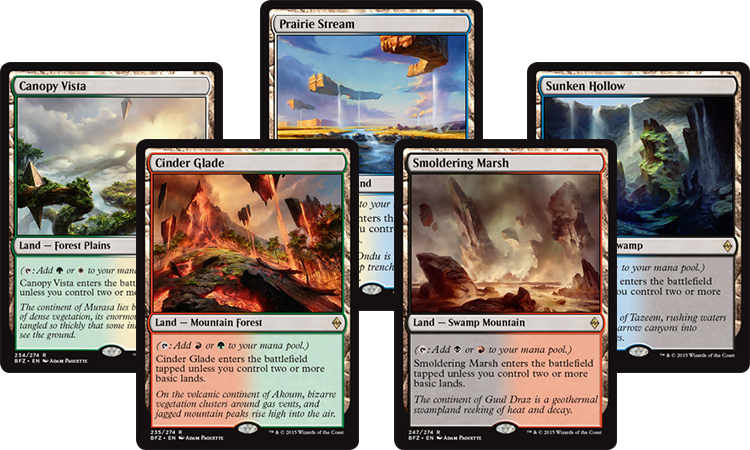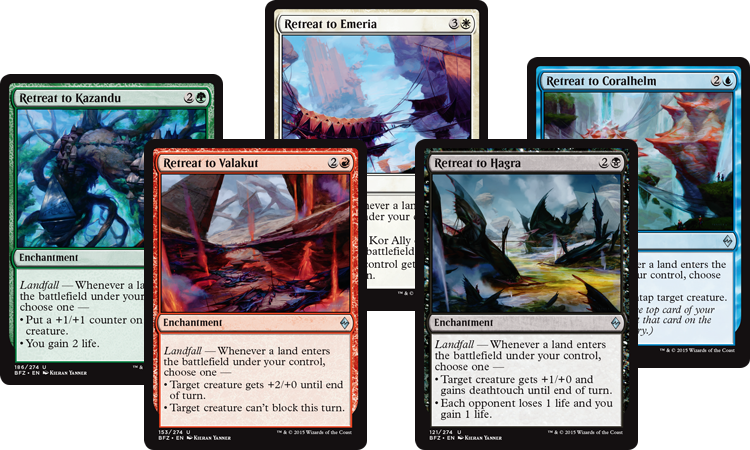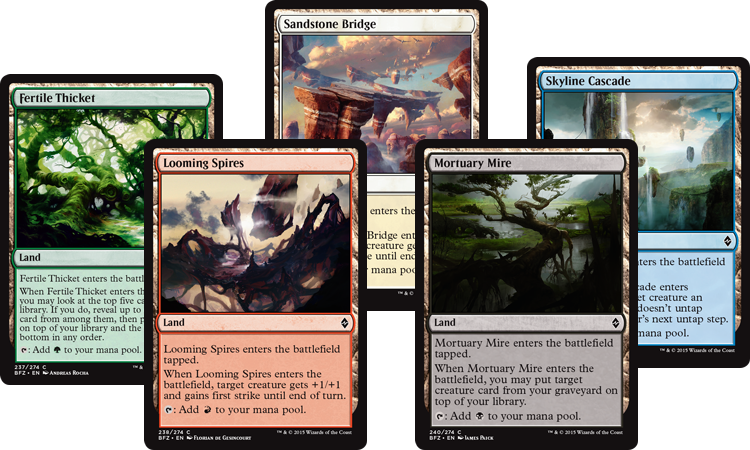Battle for Zendikards, Part 2
Last week, I began telling some card-by-card (and cycle-by-cycle) design stories. Today, I continue. As this is Part 2, I'm assuming you read Part 1. (You can read it here if you haven't.)
This card has a cute little story. I've talked about how, in an early Battle for Zendikar design meeting, we wrote down all the mechanics from Zendikar block and put them in order as to how important they were, so we could figure out which ones to bring back. Eldrazi Spawn tokens (remember that they got turned into Scions during development) were near the top of the list. In a later meeting, I asked the team if there were any cards we wanted to reprint from each mechanic near the top of our list. One card that came up was Awakening Zone.
There was just one small problem with Awakening Zone. It was green. You see, in Rise of the Eldrazi, there were Eldrazi in black, red, and green, but I wanted all the Eldrazi in Battle for Zendikar to be colorless (although some got to be devoid). Okay, we could just shift it over to a devoid version.
Once we did that, we still felt like it probably wanted to be a little different, so we started looking for a rider. What did you want to do once you got enough Eldrazi Scions out? Go get an Eldrazi, of course. We ended up making you sacrifice the card to get the Eldrazi, as we didn't want you to do it repeatedly. And that is how Awakening Zone became From Beyond.
One of the fun things about revisiting a world is that we can make nods to cards that were there last time we visited. Rise of the Eldrazi had a card called Dreamstone Hedron.
If I remember correctly, we talked about possibly reprinting Dreamstone Hedron, but I thought we needed something a little smaller, so we came up with the idea of doing a miniature version. We took the card as it is and then multiplied every number by two-thirds.
This, of course, means we're setting ourselves up for our next return to Zendikar to include a two-mana artifact that taps for one or for "1, T, Sacrifice" draws you a card.
This card messes with a design concept that I and other designers keep trying to use in a bigger way, but which keeps getting used on single cards. The ability is what I have dubbed "girth," which is the use of a number that represents the sum of a singular concept—in this case, converted mana cost. Girth is interesting mechanically because it lets a player make a choice of how to combine other cards. Do you want to get a lot of cheap Allies or a few more expensive ones?
The thing that I think keeps getting in our way is we want to keep girth open-ended. This card cares about converted mana costs, while this other card cares about power, while this third one cares about colored mana symbols. My best guess is that one day, as with devotion, I will figure out the singular use with the widest design space and make use of that. Anyway, a little hint of a potential future mechanic.
Designing a two-sided conflict can be very tricky. If you silo the two sides too much mechanically, you cut down on the possible combinations players can draft or build. That means it's important to make sure that there are mechanics, strategies, and synergies that cross over the divide. Outnumber is a good example of this.
The set has a number of cards built into it that reward having a lot of creatures. The Zendikari side has a "go wide" Ally strategy, where you want to get a lot of smaller creatures onto the battlefield to either overwhelm the opponent or generate a lot of rally effects. The Eldrazi, meanwhile, have Scion tokens that can be used to both slow down the opponent and generate mana to get larger Eldrazi out.
This is what makes Outnumber an interesting card. It can be applied to either strategy, and also enables a hybrid archetype where you mix and match the different components.
One of the keys to how Magic is made is that there's a lot of parallel processing. For instance, while design is busy creating a card file, the story team is putting together a document that spells out the cosmology of the world. This document is important, because it helps the art team as they work on worldbuilding. This means that while we are designing cards, we have the opportunity to see the world that the story and art teams are building.
Pathway Arrows is a good example of how this process can lead to card designs. The story team came up with the idea that the goblins figured out there is some connection between the Eldrazi and the hedrons, so they started using pieces of the hedrons as arrowheads. On the design side, we knew we wanted some anti-Eldrazi cards that would mechanically work well against colorless cards. Once we saw the Pathway Arrows in the design document, we realized that they would be a perfect fit for one of the anti-Eldrazi cards.
The design was completely top-down and helped us make something that suited design and mechanical needs while also reinforcing an aspect of the world the story team was eager to express. I believe this back-and-forth between different teams is one of the things that helps us make richer and more integrated sets.
One day in a design meeting, I wrote a simple question on the board: What effects would combine nicely with awaken? Awaken animates a land. When would that be extra handy? How about when you have no other creatures? Even better, how about when no one has any other creatures? We wrote "mass creature kill" on the board.
This led us to ask the next question: Would it be better to have the animating of the land happen before the normal effect or after it? Each option opened up different designs. After talking with the editing team, it was clear that when we do an additive cost for an additional effect, we tend to put it second. Do thing A. You can now pay more and do thing A plus thing B.
Luckily, this worked out perfectly for mass creature kill, because you don't want to animate your land until after every other creature is destroyed.
Prairie Stream | Sunken Hollow | Smoldering Marsh

There was much discussion about what the rare dual land cycle was going to be. Zendikar has always had a land focus, so we knew we wanted them to be impactful. The elephant in the room was the enemy fetch lands from original Zendikar. We had just reprinted the ally fetch lands in Khans of Tarkir, so there was some expectation of the enemy fetches coming back as well.
The problem was having ten fetch lands in Standard was too many. There's a balance you want to create between letting players play their two- and three-color decks without major mana issues, while not making a four- or five-color deck too easy. The color pie does important work keeping all the good cards from being in the same deck, and if we aren't careful with our mana fixing, we risk usurping the safety net of the color pie.
The challenge was this: We wanted good dual lands that helped two- and three-color decks but didn't easily enable four- and five-color decks. We also liked the idea that these lands might play nicely with the ally fetches from Khans of Tarkir. How could we accomplish this?
We started with the idea of basic land subtypes. There have only been two dual land cycles with basic land types (the original dual lands from Alpha/Beta and the "shock" lands from original Ravnica). It was a clean way to make the new duals play with the Khans fetch lands. The rules text took a few more iterations to find.
The solution came by reexamining the intended target. What do two- and three-color decks have more of than four- and five-color decks? The answer was basic lands. By caring about having basic lands, the dual cycle was able to thrive in the types of decks we wanted.
Retreat to Emeria | Retreat to Coralhelm | Retreat to Hagra
Retreat to Valakut | Retreat to Kazandu

During the preview weeks, I talked about how, when we decided to bring back landfall, we were interested in finding some new twists. The Retreat cycle is a good example of us doing this.
One of the things I like to do when tweaking a returning mechanic is to find some variable we haven't messed with yet. We've had landfall generate a lot of different effects, but I realized it's always been a single effect. What if we made landfall cards that let you choose what the effect was? My initial idea was to make landfall Charms that let you choose between three tiny effects. This idea had a few problems:
1—Three effects didn't fit in the text box
I often talk about how design has all these different rules it has to follow, but one I talk about less is physicality. One of the restrictions that we have to always keep in mind is that we have a limited amount of physical space on a Magic card. Titles can be too long. Creatures can have too many subtypes. And rules text can simply not fit.
2—Good design should slowly ramp up
We had never made a landfall card with two effects. Before ramping up to three, how about we start with two? Remember, if we go from one to two, that's exciting. If we go from one to three and then later go to two, that's less exciting. Part of mapping out design space is trying to go in an order that maximizes the excitement of each new evolution.
3—Two effects let us do larger effects
When I explored what kind of effects I could do with three choices versus two, I found that not only did two give me more options, it also made effects that felt more like what landfall would normally produce.
4—Two options better mapped to how we were handling the colors
One of the things we normally do when design hands ideas off to development is explain what we feel each two-color archetype does in Limited. With ten two-color archetypes and Retreats being a cycle of five with two options, it allowed us to make sure each archetype had a landfall effect that would be useful to that deck.
The Paths, as they were originally called in design, went into the file early and made it all the way to print. The basic structure never changed, but the effects changed many times.
Most people might not think of Rolling Thunder as an innovative Magic card, but its design came from me learning an important lesson. The very first Pro Tour Atlanta was the first (and so far last) Pro Tour to double as a Prerelease. The pros sat down and were given booster packs of Mirage, a set that no one had ever seen before, let alone played. After the event was done, R&D took all the decklists so we could look through them and see what we could learn.
One takeaway was more people played red than any other color. A lot of the decks that had red only had one red card—Kaervek's Torch.
Kaervek's Torch was an X spell, and it was so powerful that players splashed red just to play it. The next large set was Tempest, and I was leading the design (it was my first design lead, and interestingly my first design team). I was determined to correct that mistake, so my common red X spell had two red mana in its cost to make it harder to splash.
Okay, I could have moved it up to uncommon or not made it capable of killing multiple creatures, but I was trying to advance our design, and the idea of using double colored mana on powerful low-rarity cards did prove to be a valuable strategy.
I was excited to see Rolling Thunder return (it came back in development and not design) and equally happy to see it at uncommon.
Sandstone Bridge | Skyline Cascade | Mortuary Mire
Looming Spires | Fertile Thicket

The full-art basic lands and the fetch lands drew a lot of focus in Zendikar, but there were other land cycles. This cycle is a return to what we called the spell land cycle. Each was a land that produced a singular colored mana, entered the battlefield tapped, and then had an enters-the-battlefield effect. Not only did we do a cycle in Zendikar, but we also did one in Worldwake. I had liked how this cycle played in the original Zendikar block, so I decided we'd make a new one. The tricky part was to do so while staying clear of the previous two cycles.
Shambling Vent | Lumbering Falls
The number-one question about rare lands in Battle for Zendikar might have been about fetch lands, but the number-two question has definitely been about enemy-color creature lands. Worldwake did the ally cycle; would Battle for Zendikar do the enemy cycle? The answer is yes, but only partially yes. Battle for Zendikar block will complete the cycle, but Battle for Zendikar itself only has two. Why stretch it across the block? Well, there were a lot of lands in Battle for Zendikar, and we wanted to save a few for Oath of the Gatewatch.
I have explained numerous times that the devoid mechanic was inspired by the Future Sight future-shifted card Ghostfire.
This, of course, leads to the question "So Ghostfire is going to be in Battle for Zendikar block, right?" I wanted to put it in. In fact, we did put it in during design, but there was a problem. Every single devoid card in the entire block is an Eldrazi. Ghostfire represents not the Eldrazi but the colorless magic used by Ugin. Now, there's an overlap. One of the reasons Ugin was able to trap the Eldrazi in the first place is that he has a better understanding of Eldrazi magic than most.
I had numerous conversations with the creative team about whether there was any way to involve Ugin's colorless magic in the story, but in the end, it was clear that doing so would just cause confusion. I talk a lot about how an important part of design is consistency, so the audience understands how things work. Throwing one non-Eldrazi devoid spell in the mix just led to awkward design.
Perhaps, then, we could include the card but reskin it. We could give it an Eldrazi flavor and say that the possible future hinted at in Future Sight was close but not exact. The problem with that solution is that we have rules about what makes a devoid card (I shared them last week) and Ghostfire didn't quite fit.
So here's what we did: We made one more tiny change. We added a rider that exiled the creature if it died. And then in development, red was a little strong and they needed to balance something, so Touch of the Void went from being an instant to a sorcery.
So where's Ghostfire? Here. Kind of. The potential future we saw in Future Sight was close to our reality, but off in a few ways. And no, Ghostfire is not in Oath of the Gatewatch.
An interesting question I've gotten about Ulamog is why his original card in Rise of the Eldrazi had an anti-reanimation rider while the new version does not. The big answer is we've made a conscious choice to put the responsibility of reanimating giant creatures not on each giant creature but rather on the reanimation spells. That's why we've made them more expensive and moved them up in rarity. This felt like a better plan than having to add an extra clause onto every big creature.
This card is a relic from an earlier part of design where the Eldrazi had a fascination with odd numbers. The wordplay of Eldrazi liking "odd" things tickled my funny bone, and I appreciated them caring about something that no one else ever cares about. How often do you build a deck and go, "Oops, I need more creatures with odd converted mana costs"?
My favorite card from this time period was a colorless enchantment that simply said "All odd numbers are even."
The End Is Near
That's all the time we have today. I hope you've enjoyed my jaunt this week and last through a number of cards and cycles from Battle for Zendikar. As always, I would love to hear any feedback on today's column through my email or any of my social media accounts (Twitter, Tumblr, Google+, and Instagram).
Join me next week when [REDACTED].
Until then, may you have as much fun rediscovering Zendikar as we did.
"Drive to Work #264—Creative Process, Part 1"
"Drive to Work #265—Creative Process, Part 2"
This is a two-part podcast series all about the creative process. I talk about my take on how I think the creative process works, with tips about how one can improve at it.
- Episode 265 Creative Process, Part 2 (18.0 MB)
- Episode 264 Creative Process, Part 1 (17.2 MB)
- Episode 263 2012 (14.4 MB)
- Episode 262 Khans of Tarkir, Part 7 (17.5 MB)
- Episode 261 Khans of Tarkir, Part 6 (17.3 MB)

